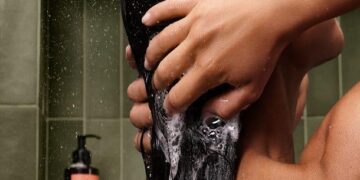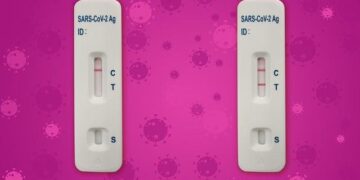Table of Contents
Introduction: The Sound of Suffering
The clock on the nightstand glows: 3:17 A.M. In the suffocating quiet of the house, a sound begins.
Thump.
Thump.
Thump-thump-thump. It’s a frantic, muffled rhythm against the hardwood floor, the soundtrack to a shared misery.
It’s the sound of Leo, a spirited West Highland White Terrier, trying to claw his way out of his own skin.
For his owner, lying awake in the dark, it’s more than an annoyance; it’s the sound of helplessness, a percussive reminder of a battle they are losing.
This relentless scratching, chewing, and licking has become the central crisis of their lives, straining the joyful bond that once defined their relationship.1
Guilt and frustration are constant companions.
Every failed remedy, every expensive vet bill, every well-meaning but useless piece of advice chips away at hope.
This isn’t just a medical problem; it’s a quality-of-life emergency for the entire household.
The owner is haunted by the same questions night after night:
Why is this happening? What am I missing? This is the story of their journey into the allergy abyss and the hard-won knowledge that finally brought them, and Leo, the sound of silence.
Part I: The Allergy Abyss
The descent into the world of canine skin allergies is a confusing and frustrating ordeal, marked by visible suffering and a bewildering array of potential causes and ineffective treatments.
For Leo and his owner, it was a war fought on multiple fronts against an invisible enemy.
A Fortress Under Siege: Diagnosing the Invisible Enemy
Leo’s body was a battlefield.
The war was evident in the frantic licking of his paws until the white fur turned a rusty brown from salivary staining.2
It was visible on his belly, where the skin was an angry, inflamed R.D.3
It showed in the patches of hair loss at the base of his tail, a classic sign of intense irritation.4
Worst of all were the “hot spots”—raw, weeping lesions also known as acute moist dermatitis—that would appear seemingly overnight, a painful testament to his non-stop self-trauma.2
These weren’t just cosmetic flaws; they were the clear signs of a body at war with its environment and, ultimately, itself.
To understand the fight, one must first understand the enemy.
Canine skin allergies, or allergic dermatitis, are the most common type of allergic reaction in dogs and typically stem from three major sources.3
- Environmental (Atopic) Dermatitis: This is an inherited predisposition to developing allergic reactions to everyday substances. For dogs like Leo, the world is full of triggers: pollens, molds, dust mites, and dander.2 This condition is remarkably common, affecting an estimated 10-15% of the dog population, with signs often emerging between six months and three years of age—a perfect fit for Leo’s profile.2 The resulting itch often targets the paws, ears, muzzle, and underarms.4
- Food Allergies: Less common but still significant, a true food allergy is an immune system response to an ingredient, most often a protein like beef or chicken, but sometimes grains like wheat or corn.4 This typically manifests as itchy skin, particularly around the paws and ears, and can be accompanied by gastrointestinal issues like vomiting or diarrhea.3
- Flea Allergy Dermatitis (FAD): This is not an allergy to fleas themselves, but a severe hypersensitivity to proteins in flea saliva. For a dog with FAD, a single bite can ignite a firestorm of intense itching, usually concentrated at the base of the tail.1
The initial allergic reaction, however, is often just the opening salvo.
The real crisis begins with the vicious cycle of secondary infections.
As a dog scratches, licks, and chews at their irritated skin, they create microscopic tears and abrasions.
This breach in the skin’s defenses becomes an open invitation for opportunistic bacteria and yeast to invade.2
Bacterial infections (pyoderma) can cause pustules and crusts, while yeast infections (
Malassezia dermatitis) lead to greasy skin, a musty odor often compared to corn chips, and even more intense itching.7
This creates a miserable, self-perpetuating loop: the allergy causes the itch, the itch damages the skin, the damaged skin gets infected, and the infection makes the itch exponentially worse.1
Simply treating the itch without addressing these secondary invaders is like trying to bail out a boat with a hole in it.
The Carousel of Failed Cures
Leo’s owner, like so many others, found themselves trapped on a carousel of treatments that promised relief but delivered only temporary fixes and mounting frustration.
This journey is a familiar one, echoed in the desperate posts of countless dog owners online.1
The process is not only emotionally draining but also a significant financial burden.5
The first stop was the veterinarian, where a course of corticosteroids like prednisone brought blessed, albeit brief, silence.
The frantic scratching subsided, and for a week, it seemed the nightmare was over.
But as soon as the medication ended, the itch returned with a vengeance, leaving the owner worried about the potential long-term side effects of repeated steroid use.1
Next came the pilgrimage to the pet store, a dizzying gauntlet of shampoos lining the shelves.
They tried everything: cheap store brands, formulas with appealing oatmeal and aloe graphics, and even beautifully packaged bottles with “lovely lavender” coloring and fragrances.10
Some did nothing at all.
Others, inexplicably, seemed to make Leo’s skin even redder and itchier after a bath.
Driven by desperation, the owner plunged into the rabbit hole of online forums.
Here, they found a dizzying array of anecdotal advice, much of it conflicting.
One post would swear by apple cider vinegar rinses; another would suggest adding more fat to the diet; a third recommended homemade soap.9
The owner felt lost in a sea of information, a feeling captured perfectly by the owner of an allergic German Shepherd who described the diagnostic journey as an “excruciatingly slow process”.1
This carousel of failed cures underscores a fundamental misunderstanding of the problem.
By focusing solely on stopping the itch, the owner was merely silencing the alarm, while the underlying fire—a complex immune reaction driven by a fundamentally compromised skin barrier—continued to rage unchecked.
True relief would only come from understanding
why the alarm was sounding in the first place.
Part II: The Epiphany
The turning point in this journey was not a new medication or a miracle cure.
It was knowledge.
Fueled by frustration and a refusal to accept Leo’s suffering as a permanent state, his owner embarked on their own research, leading to two critical epiphanies that would fundamentally change their approach and ultimately lead to healing.
Decoding the Fortress: The Skin Barrier Breakthrough
One night, while scrolling through veterinary articles, Leo’s owner stumbled upon a simple but profoundly illuminating analogy: the skin’s outermost layer, the stratum corneum, functions like a brick-and-mortar wall.11
This was the “aha!” moment that unlocked everything.
The science, once intimidating, became crystal clear through this powerful metaphor.
- The Bricks: The skin cells, called corneocytes, are the strong, protein-rich bricks that provide the skin’s structure.11
- The Mortar: The “glue” holding these bricks together is an intercellular matrix of lipids—essential fats and oils. The most critical component of this mortar is a class of lipids called ceramides.11 This lipid mortar is the key to the wall’s function: it locks in moisture to keep the skin hydrated and supple, and it forms an impermeable barrier that keeps harmful allergens, bacteria, and chemical irritants out.13
With this new understanding, the true nature of Leo’s condition snapped into focus.
Scientific research has established that dogs with atopic dermatitis, like many West Highland White Terriers, have a genetically defective epidermis.2
Specifically, they suffer from a
ceramide deficiency.16
Their “mortar” is inherently weak, crumbling, and full of gaps.
This single biological defect explained all of Leo’s symptoms:
- Chronic Dryness and Itching: The compromised barrier cannot effectively hold water. This leads to transepidermal water loss, leaving the skin perpetually dehydrated, flaky, and itchy.11
- Heightened Allergic Reactions: The “leaky” barrier allows environmental allergens like pollen and dust mites to easily penetrate the skin’s outer defenses. Once inside, these allergens trigger the immune system to launch an aggressive inflammatory response, resulting in the redness, swelling, and intense itch that defined Leo’s suffering.2
The owner finally grasped the profound truth: they weren’t just fighting an allergy.
They were trying to defend a fortress with crumbling walls.
The enemy wasn’t just outside; the weakness was built into the very structure of the defense itself.
The Enemy in the Bottle: Unmasking “Greenwashed” Deception
Armed with the “skin barrier” lens, Leo’s owner looked with new eyes at the collection of failed shampoos on their bathroom shelf.
This led to the second shockwave: the discovery of “greenwashing.” This is a pervasive and deceptive marketing tactic where companies label their products as “natural,” “gentle,” or “organic” to appeal to conscientious consumers, while the formulas are actually packed with harsh, synthetic chemicals that can harm sensitive skin.18
The owner became an ingredient detective, and what they found was horrifying.
The very products they had been using to “soothe” Leo’s skin contained chemicals known to actively dismantle the skin’s lipid mortar.
- Sulfates (Sodium Lauryl Sulfate/SLS, Sodium Laureth Sulfate/SLES): These are harsh detergents responsible for the rich, satisfying lather many people associate with being clean. In reality, they are powerful degreasers that strip the skin of its natural oils—the very lipids that make up the mortar—leaving the barrier weaker, drier, and more irritated than before.10
- Parabens (e.g., methylparaben, propylparaben): These are chemical preservatives used to extend shelf life. They are known to be absorbed through the skin and can act as endocrine disruptors, potentially interfering with hormonal balance over time.10
- Artificial Fragrances and Dyes: A label that simply says “Fragrance” is a red flag. This term can hide a cocktail of hundreds of undisclosed chemicals, including phthalates, which are also endocrine disruptors and common skin irritants.10 The owner grimly recalled the “lovely lavender colour” of one shampoo, realizing it was likely derived from petroleum and served no purpose other than to appeal to the human buyer.10
- Formaldehyde-Releasing Preservatives: This was the most shocking discovery. Ingredients like DMDM hydantoin, imidazolidinyl urea, and quaternium-15 are used to prevent bacterial growth in the bottle. However, they work by slowly releasing formaldehyde, a substance classified as a known carcinogen and a potent skin irritant that can cause burning and blistering.10
The ultimate betrayal was the realization that the shampoos purchased with the best intentions were not just ineffective; they were active participants in Leo’s suffering.
They were chemical wrecking balls, systematically breaking down his already fragile skin barrier with every bath.
This discovery was born from the fact that the pet shampoo industry is largely unregulated; unless a product makes a specific medical claim, the FDA does not oversee its formulation.23
This lack of oversight allows the marketplace to be flooded with products that use misleading terms like “natural” on their labels, preying on the desperation of owners and perpetuating a cycle of failure and frustration.
This wasn’t a personal failure; it was a systemic one.
The anger this realization sparked was quickly channeled into empowerment.
The owner now knew exactly what to avoid.
Part III: Rebuilding the Wall
With the enemy identified and the nature of the battle understood, the final phase of the journey began: rebuilding the fortress.
This wasn’t about finding a single “magic shampoo” but about assembling an arsenal of therapeutic tools and adopting a holistic strategy to restore Leo’s skin barrier, calm the inflammation, and finally bring him lasting peace.
The Holy Trinity of Healing: Ingredients That Rebuild and Soothe
The shopping philosophy changed entirely.
The goal was no longer to find a “cleanser” but a topical therapy designed to actively repair and defend the skin.
This meant seeking out specific, science-backed ingredients that could rebuild the wall from the outside in.
- Ingredient Deep Dive #1: Colloidal Oatmeal – The Soothing Shield
Colloidal oatmeal is not just ground-up breakfast food. It is a specific preparation of finely milled oats that is recognized by the FDA as an over-the-counter skin protectant.24 Its power lies in a dual-action mechanism. First, it acts as an
emollient, forming a physical, protective film over the skin. This shield locks in precious moisture and protects the compromised barrier from environmental pollutants.26 Second, it is a potent
anti-inflammatory. Oats contain a unique group of polyphenols called avenanthramides, which have been shown to inhibit the release of pro-inflammatory cytokines, the very chemical messengers that trigger itching and redness.24 It also helps to buffer and normalize the skin’s pH, creating a healthier environment.26 - Ingredient Deep Dive #2: Aloe Vera – The Healing Hydrator
The gel of the Aloe Vera plant is far more than a simple moisturizer. It is a biochemical powerhouse for skin repair. The gel contains compounds like glucomannans that directly stimulate fibroblast growth and increase collagen synthesis, actively accelerating the healing of wounds, hot spots, and abrasions.28 Furthermore, its natural anti-inflammatory, antibacterial, and antifungal properties make it an ideal ingredient for skin prone to the secondary infections that plague allergic dogs.28 One of its compounds, magnesium lactate, can even inhibit the production of histamine, providing a direct mechanism for itch relief.29 - Ingredient Deep Dive #3: Ceramides – The Master Mortar
This is the capstone ingredient for barrier repair. As established, dogs with atopic dermatitis have a quantifiable deficiency in ceramides—the very lipids that form the “mortar” of the skin barrier.16 Applying ceramides topically through a shampoo is a direct form of therapy. It is the dermatological equivalent of re-grouting the crumbling mortar between the bricks. This process directly reinforces the skin’s physical structure, dramatically improves its ability to retain moisture, and reduces its permeability to the allergens that trigger the immune system.17 Shampoos formulated with a “triple ceramide complex” offer a particularly targeted approach to this essential repair work.33
Choosing the Champion: A Guide to the Hypoallergenic Aisle
Armed with this new knowledge, navigating the pet care aisle became a mission, not a gamble.
The criteria for a worthy product were now non-negotiable:
- Free of the “Hit List”: The label must be free of sulfates, parabens, phthalates, artificial fragrances, synthetic dyes, and formaldehyde-releasing preservatives.10
- Contains the “Holy Trinity”: The formula should be built around beneficial ingredients like colloidal oatmeal, aloe vera, and, for maximum repair, ceramides.
- pH-Balanced and Soap-Free: These features are critical to ensure the shampoo doesn’t strip the skin’s delicate acid mantle, which is a dog’s natural first line of defense.21
Veterinarian-recommended brands often exemplify these principles.
Products like Douxo S3 CALM Shampoo are praised specifically for their ability to strengthen the skin barrier, while Virbac Epi-Soothe Shampoo is a trusted, oat-derived, soap-free formula used in veterinary clinics.37
Another widely available option,
Vet’s Best Hypo-Allergenic Shampoo, is formulated with soothing aloe vera and Vitamin E.39
The point is not to endorse a single product, but to recognize the characteristics of a high-quality therapeutic formula.
However, sometimes general sensitivity is complicated by active infections.
For a pet owner, knowing what to look for on a label can mean the difference between providing relief and making things worse.
| Decoding Your Dog’s Needs: Selecting the Right Therapeutic Shampoo | ||
| Primary Symptom/Condition | Likely Underlying Issue | Key Active Ingredients to Look For |
| General Itchiness, Dryness, Flaking, Mild Redness | Compromised Skin Barrier, Atopic/Contact Allergies | Barrier Repair & Soothing Agents: Colloidal Oatmeal, Aloe Vera, Ceramides, Essential Fatty Acids. (Look for “Hypoallergenic,” “Sensitive Skin” formulas). 17 |
| Greasy/Oily Coat, Musty “Corn Chip” Odor, Flaky Skin, Intense Itching (esp. paws, ears, belly) | Yeast Infection (Malassezia Dermatitis) | Antifungals: Miconazole, Ketoconazole. Often combined with antibacterials. (Look for “Antifungal,” “Medicated” formulas). 7 |
| Pimples, Pustules, Red Bumps, Crusty Sores, “Hot Spots” (Acute Moist Dermatitis) | Bacterial Infection (Pyoderma), often secondary to allergies. | Antibacterials/Antiseptics: Chlorhexidine, Benzoyl Peroxide. Often combined with antibacterials. (Look for “Antiseptic,” “Antibacterial,” “Medicated” formulas). 8 |
This framework transforms a confused consumer into an empowered advocate, able to match observable symptoms to the correct therapeutic ingredients, ensuring they either select the right over-the-counter product or have a highly informed conversation with their veterinarian.
Beyond the Bath: An Integrated Blueprint for an Itch-Free Life
The final piece of the puzzle was understanding that even the perfect shampoo is a tool, not a cure-all.
Lasting relief for Leo required a holistic strategy where topical therapy served as the cornerstone that enabled other treatments to succeed.
A raw, infected, and inflamed skin barrier cannot fully benefit from other interventions.
By first using the right shampoo to calm the skin, clear infections, and begin repairing the barrier, a stable foundation was created.
- Fortifying the Wall from the Inside Out: Diet became a key focus. Adding Omega-3 and Omega-6 fatty acids from sources like fish oil or flaxseed helps to reduce inflammation systemically. Transitioning to a limited-ingredient diet built around a novel protein—one the dog has never eaten before, like salmon, duck, or venison—can help manage or rule out underlying food allergies.43
- Maintaining a Perimeter Defense: The importance of strict, year-round, veterinarian-recommended flea and tick control cannot be overstated. For a dog with flea allergy dermatitis, a single flea bite can trigger a massive flare-up, undoing weeks of progress.1
- The Alliance with the Veterinarian: The journey culminated in a new, collaborative relationship with the vet. No longer a passive recipient of prescriptions, Leo’s owner was now an informed partner in his care. They could discuss symptoms with precision, ask questions about specific ingredients, and work together to fine-tune a long-term management plan.3
Conclusion: The Sound of Silence
It’s 3:17 A.M. again.
The house is still.
The only sound is the soft, rhythmic breathing of a dog deep in slumber.
Leo is at peace, his body finally comfortable in his own skin.
His owner, watching him from the doorway, is also at peace, the gnawing anxiety replaced by the quiet confidence of knowledge.
The journey from helpless frustration to empowered advocacy was long, but the destination was worth it.
The solution was not a single product, but a paradigm shift—from treating a symptom to healing a system.
It was about understanding the skin as a fortress, recognizing the enemies that would tear it down, and learning to choose the tools that would rebuild it, brick by brick and mortar by mortar.
Your dog can’t read an ingredient list, but you can.
The journey to an itch-free life begins not in the pet aisle, but with the decision to become their expert.
Works cited
- Allergies and Itchy Dogs | Dog Food Advisor, accessed August 13, 2025, https://www.dogfoodadvisor.com/forums/topic/allergies-and-itchy-dogs/
- Atopic dermatitis (atopy) | Cornell University College of Veterinary …, accessed August 13, 2025, https://www.vet.cornell.edu/departments-centers-and-institutes/riney-canine-health-center/canine-health-information/atopic-dermatitis-atopy
- Dog Skin Allergies: Causes, Symptoms & Treatment – Animal Hospital of Clemmons, accessed August 13, 2025, https://www.animalhospitalofclemmons.com/site/veterinary-pet-care-blog/2020/11/05/dog-skin-allergies-causes-symptoms-treatment
- Dog Skin Allergies: What to Know – American Kennel Club, accessed August 13, 2025, https://www.akc.org/expert-advice/health/dog-skin-allergies/
- Skin allergies in dogs – PDSA, accessed August 13, 2025, https://www.pdsa.org.uk/pet-help-and-advice/pet-health-hub/conditions/skin-allergies-atopic-dermatitis-in-dogs
- Recognizing the Signs of Skin Allergies in Dogs – Blog – McMillin Animal Hospital, accessed August 13, 2025, https://mcmillinvet.com/blog/the-benefits-of-pet-boarding
- How to Bathe Dogs with Medicated Shampoo | VCA Animal Hospitals, accessed August 13, 2025, https://vcahospitals.com/know-your-pet/how-to-bathe-dogs-with-medicated-shampoo
- Choosing the Right Shampoo for Pets by Gladesville Veterinary Hospital, accessed August 13, 2025, https://www.gladesvillevet.com.au/pet-health-care-information/shampoos/
- Desperate for help with dog itching/scratching problem – Permies.com, accessed August 13, 2025, https://permies.com/t/11303/Desperate-dog-itching-scratching
- Worst Ingredients In Your Dog Shampoos That Must Be Avoided …, accessed August 13, 2025, https://www.moepuppy.com/blogs/news/bad-ingredients-in-dog-shampoo
- Understanding Your Skin Barrier – Herron Dermatology & Laser, accessed August 13, 2025, https://www.herrondermatology.com/understanding-your-skin-barrier/
- Are ‘Broken Skin Barriers’ a Real Thing? – Time Magazine, accessed August 13, 2025, https://time.com/7212990/what-is-broken-skin-barrier-dermatologists/
- What Is Your Skin Barrier, and How Do You Protect It? An Expert Explains – GoodRx, accessed August 13, 2025, https://www.goodrx.com/health-topic/dermatology/skin-barrier-repair
- Understanding the Epidermal Barrier in Healthy and Compromised Skin: Clinically Relevant Information for the Dermatology Practitioner: Proceedings of an Expert Panel Roundtable Meeting, accessed August 13, 2025, https://pmc.ncbi.nlm.nih.gov/articles/PMC5608132/
- The skin: an indispensable barrier – PubMed, accessed August 13, 2025, https://pubmed.ncbi.nlm.nih.gov/19043850/
- An update on the treatment of canine atopic dermatitis – PMC, accessed August 13, 2025, https://pmc.ncbi.nlm.nih.gov/articles/PMC6067670/
- Ceramides for dogs: A complete guide | ElleVet Sciences, accessed August 13, 2025, https://www.ellevetsciences.com/pet-care/ceramides-for-dogs-a-complete-guide/
- 16 Dog Shampoo Ingredients To Avoid Using – The Natural Dog Store, accessed August 13, 2025, https://thenaturaldogstore.com/blogs/health/dog-shampoo-ingredients-to-avoid
- Is Your Dog’s Shampoo Natural? – Four Leaf Rover, accessed August 13, 2025, https://fourleafrover.com/blogs/natural-health/natural-dog-shampoo
- Lesson 1: How to See Through the Marketing Claims of Natural Dog Shampoo – 4-Legger, accessed August 13, 2025, https://www.4-legger.com/blogs/fetch-the-dog-blog/the-top-5-lessons-for-buying-a-truly-safe-and-non-toxic-dog-shampoo
- The “Pawsome” Truth About Dog Shampoos: What Ingredients to Look For (and Avoid!), accessed August 13, 2025, https://thegrandpaw.com/the-pawsome-truth-about-dog-shampoos-what-ingredients-to-look-for-and-avoid/
- The Top 10 Ingredients to Avoid in Dog Shampoos and Why – u groom, accessed August 13, 2025, https://www.ugroom.com.au/blogs/news/the-top-10-ingredients-to-avoid-in-dog-shampoos-and-why
- Worst Dog Shampoo Ingredients To Avoid Using – Fidose of Reality, accessed August 13, 2025, https://fidoseofreality.com/the-dangers-of-dog-shampoos/
- What Is Colloidal Oatmeal? Benefits, Uses, and Safety – Healthline, accessed August 13, 2025, https://www.healthline.com/nutrition/colloidal-oatmeal
- Colloidal oatmeal: history, chemistry and clinical properties – PubMed, accessed August 13, 2025, https://pubmed.ncbi.nlm.nih.gov/17373175/
- Colloidal Oatmeal – What is it? And why it’s good for your dog’s skin and coat – Doglyness, accessed August 13, 2025, https://www.doglyness.com/blogs/news/colloidal-oatmeal-what-is-it-and-why-its-good-for-your-dogs-skin
- The Powerful Topical Benefits of Colloidal Oatmeal for Pets Explained – HICC Pet, accessed August 13, 2025, https://hiccpet.com/blogs/dogs/the-powerful-topical-benefits-of-colloidal-oatmeal-for-pets-explained
- The Topical Benefits of Aloe Vera for Dogs and Cats, accessed August 13, 2025, https://pharmaloe.com/blogs/pharm-aloe-for-pets/the-topical-benefits-of-aloe-vera-for-dogs-and-cats
- The Effect of Aloe Vera Clinical Trials on Prevention and Healing of Skin Wound: A Systematic Review, accessed August 13, 2025, https://pmc.ncbi.nlm.nih.gov/articles/PMC6330525/
- Can You Use Aloe Vera on Dogs? A Guide to Safe Usage, accessed August 13, 2025, https://thedogdoctors.co.uk/blogs/news/can-you-use-aloe-vera-on-dogs-a-guide-to-safe-usage
- Ceramide Shampoo – Gallon – Davis Manufacturing, accessed August 13, 2025, https://davismfg.com/ceramide-shampoo-gallon-cesg
- Ceramide Shampoo for Animal Use – Drugs.com, accessed August 13, 2025, https://www.drugs.com/vet/ceramide-shampoo.html
- CeraDerm Aloe and Oatmeal Conditioning Shampoo for Dogs or Cats, 1 Gallon | On Sale, accessed August 13, 2025, https://www.entirelypets.com/ceraderm-aloe-oatmeal-conditioning-shampoo-dogs-cats-1gl.html
- CeraDerm Aloe and Oatmeal Conditioning Shampoo for Dogs or Cats, 1 Gallon, accessed August 13, 2025, https://healthypets.com/ceraderm-aloe-oatmeal-conditioning-shampoo-dogs-cats-1gl/
- How to Choose the Best Hypoallergenic Dog Shampoo – Nuesta Pets, accessed August 13, 2025, https://nuestapets.com/blogs/news/how-to-choose-the-best-hypoallergenic-dog-shampoo
- nuestapets.com, accessed August 13, 2025, https://nuestapets.com/blogs/news/how-to-choose-the-best-hypoallergenic-dog-shampoo#:~:text=When%20shopping%20for%20a%20hypoallergenic,Pets%20Unscented%20Oatmeal%20Dog%20Shampoo.
- www.petmd.com, accessed August 13, 2025, https://www.petmd.com/dog/vet-verified/best-dog-shampoos#:~:text=Our%20veterinary%20panel%20picked%20Douxo’s,skin%20and%20addressing%20mild%20itchiness.
- 7 Best Dog Shampoos in 2025, Recommended by Vets | PetMD, accessed August 13, 2025, https://www.petmd.com/dog/vet-verified/best-dog-shampoos
- Dog Hypo-Allergenic Shampoo – Vet’s Best, accessed August 13, 2025, https://vetsbest.com/products/hypo-allergenic-dog-shampoo
- How to Pick the Right Shampoo – Dermcare, accessed August 13, 2025, https://dermcare.com.au/news/how-to-pick-the-right-shampoo/
- The 8 Best Antifungal Shampoos for Dogs – Rover.com, accessed August 13, 2025, https://www.rover.com/blog/anti-fungal-dog-shampoo/
- Does Your Dog Need a Medicated Shampoo? – Chewy, accessed August 13, 2025, https://www.chewy.com/education/dog/grooming/does-my-dog-need-a-medicated-dog-shampoo
- 10 Best Sensitive Skin Dog Foods 2025: According to Reviews | Chewy, accessed August 13, 2025, https://www.chewy.com/best/sensitive-skin-dog-foods_s157342
- Soothing Sensitive Skin & Stomachs in Dogs and Cats – Wellness Pet Food, accessed August 13, 2025, https://www.wellnesspetfood.com/blog/soothing-sensitive-skin-stomachs-what-diet-is-best-for-your-pet/
- 3 Top Recommended Dog Foods for Sensitive Skin – Simply Naked Pet Food, accessed August 13, 2025, https://simplynakedpetfood.com/blogs/fish-based-pet-food-resources/top-dog-foods-for-sensitive-skin






